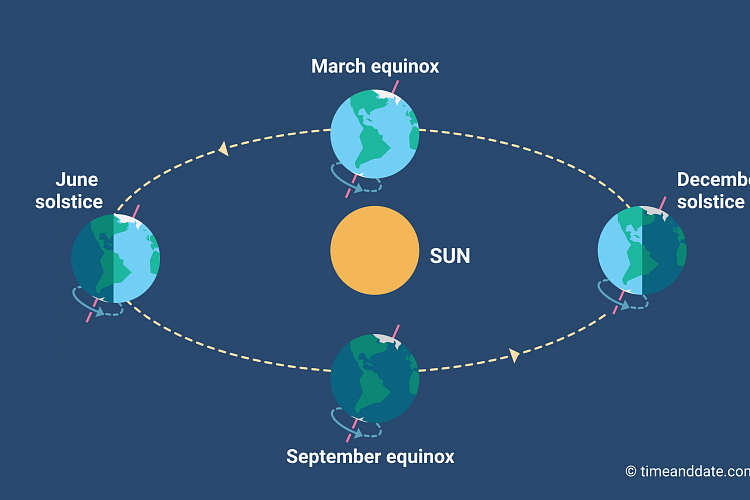June Solstice: Longest and Shortest Day of the Year

The June solstice is the Summer Solstice in the Northern Hemisphere and the Winter Solstice the Southern Hemisphere.

The June Solstice. (Not to scale)
The date varies between June 20 and June 22, depending on the year, and the local time zone.
June Solstice in Citrus Heights, California, USA is on
Tuesday, June 20, 2017 at 9:24 pm PDT (Change city)
Tuesday, June 20, 2017 at 9:24 pm PDT (Change city)
- Local times for June Solstice 2017 worldwide
- Sunrise, sunset and day length around June Solstice 2017
- Day and Night map for June Solstice 2017
- Countdown to June Solstice 2017 in Citrus Heights, California, USA
- Equinoxes and solstices from 2000–2049
Zenith Furthest Away from the Equator
A solstice happens when the sun's zenith is at its furthest point from the equator. On the June solstice, it reaches its northernmost point and the Earth’s North Pole tilts directly towards the sun, at about 23.4 degrees.
It's also known as the northern solstice because it occurs when the sun is directly over the Tropic of Cancer in the Northern Hemisphere.
Meaning of Solstice
'Solstice' (Latin: 'solstitium') means 'sun-stopping'. The point on the horizon where the sun appears to rise and set, stops and reverses direction after this day. On the solstice, the sun does not rise precisely in the east, but rises to the north of east and sets to the north of west, meaning it's visible in the sky for a longer period of time.
Although the June solstice marks the first day of astronomical summer, it's more common to use meteorological definitions of seasons, making the solstice midsummer or midwinter.

Solstices in Culture
Over the centuries, the June solstice has inspired countless festivals, midsummer celebrations and religious holidays.
One of the world's oldest evidence of the Summer Solstice's importance in culture is Stonehenge in England, a megalithic structure which clearly marks the moment of the June Solstice.
In the Southern Hemisphere, where the June solstice is known as the shortest day of the year, it marks the first day of astronomical winter, but the middle of winter in meteorological terms.
Midnight Sun or Polar Night?
On the June solstice, the midnight sun is visible (weather permitting) throughout the night, in all areas from just south of the Arctic Circle to the North Pole.
On the other side of the planet, south of the Antarctic Circle there's Polar Night, meaning no Sunlight at all, on the June Solstice.
Solstice Dates Vary
Even though most people consider June 21 as the date of the June Solstice, it can happen anytime between June 20 and June 22, depending on which time zone you're in. June 22 Solstices are rare - the last June 22 Solstice in UTC time took place in 1975 and there won't be another one until 2203.
The varying dates of the solstice are mainly due to the calendar system – most western countries use the Gregorian calendarwhich has 365 days in a normal year and 366 days in a Leap Year.
A tropical year is the time it takes the Earth to orbit once around the Sun. It is around 365.242199 days long, but varies slightly from year to year because of the influence of other planets. The exact orbital and daily rotational motion of the Earth, such as the “wobble” in the Earth's axis (precession of the equinoxes), also contributes to the changing solstice dates.
Moving to Other Seasons

After the June solstice, the sun follows a lower and lower path through the sky each day in the Northern Hemisphere until it reaches the point where the length of daylight is about 12 hours and eight to nine minutes in areas that are about 30 degrees north or south of the equator.
Areas 60 degrees north or south of the equator have daylight for about 12 hours and 16 minutes. This is the September Equinox, the Autumnal Equinox in the Northern Hemisphere.
Earth does not move at a constant speed in its elliptical orbit. Therefore the seasons are not of equal length: the times taken for the sun to move from the March Equinox to the June Solstice, to the September equinox, to the December solstice, and back to the March equinox are roughly 92.8, 93.6, 89.8 and 89.0 days respectively.
The consolation in the Northern Hemisphere is that spring and summer last longer than autumn and winter.June Solstice - Summer and Winter Solstice:

